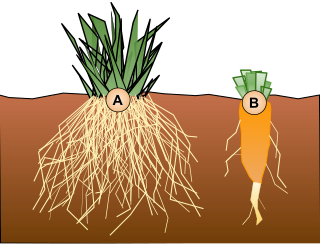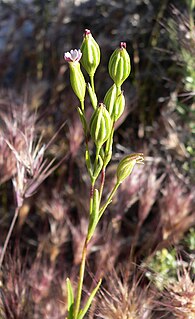| Silene seelyi | |
|---|---|
| Scientific classification | |
| Kingdom: | Plantae |
| (unranked): | Angiosperms |
| (unranked): | Eudicots |
| (unranked): | Core eudicots |
| Order: | Caryophyllales |
| Family: | Caryophyllaceae |
| Genus: | Silene |
| Species: | S. seelyi |
| Binomial name | |
| Silene seelyi Morton & J.W.Thomp. | |
Silene seelyi is a species of flowering plant in the pink family known by the common names Seely's catchfly [1] and Seely's silene. It is endemic to Washington State in the United States, where it is limited to the Wenatchee Mountains of Chelan and Kittitas Counties. [2]

Caryophyllaceae, commonly called the pink family or carnation family, is a family of flowering plants. It is included in the dicotyledon order Caryophyllales in the APG III system, alongside 33 other families, including Amaranthaceae, Cactaceae, and Polygonaceae. It is a large family, with 81 genera and about 2,625 known species.

Endemism is the ecological state of a species being unique to a defined geographic location, such as an island, nation, country or other defined zone, or habitat type; organisms that are indigenous to a place are not endemic to it if they are also found elsewhere. The extreme opposite of endemism is cosmopolitan distribution. An alternative term for a species that is endemic is precinctive, which applies to species that are restricted to a defined geographical area.

Washington, officially the State of Washington, is a state in the Pacific Northwest region of the United States. Named for George Washington, the first president of the United States, the state was made out of the western part of the Washington Territory, which was ceded by Britain in 1846 in accordance with the Oregon Treaty in the settlement of the Oregon boundary dispute. It was admitted to the Union as the 42nd state in 1889. Olympia is the state capital; the state's largest city is Seattle. Washington is sometimes referred to as Washington State, to distinguish it from Washington, D.C., the capital of the United States, which is often shortened to Washington.
This perennial herb grows from a taproot and branching caudex. The branching stems are up to 30 centimeters long. The thin leaves are mainly lance-shaped and measure up to 2 centimeters long. They are oppositely arranged on the stem. The inflorescence contains many leaves and a few flowers. The flowers have bell-shaped calyces of green sepals and lobed petals which may be dark red, white or purplish. [3] [4]

A perennial plant or simply perennial is a plant that lives more than two years. The term is often used to differentiate a plant from shorter-lived annuals and biennials. The term is also widely used to distinguish plants with little or no woody growth from trees and shrubs, which are also technically perennials.

Herbaceous plants are plants that have no persistent woody stem above ground. The term is mainly applied to perennials, but in botany it may also refer to annuals or biennials, and include both forbs and graminoids.

A taproot is a large, central, and dominant root from which other roots sprout laterally. Typically a taproot is somewhat straight and very thick, is tapering in shape, and grows directly downward. In some plants, such as the carrot, the taproot is a storage organ so well developed that it has been cultivated as a vegetable.
This plant grows on cliffs. It can be found in shady crevices on steep slopes and talus. Other species in the habitat my include alumroot (Heuchera cylindrica), Chelan penstemon (Penstemon pruinosus) and Wallace's selaginella (Selaginella wallacei). [5]

Scree is a collection of broken rock fragments at the base of crags, mountain cliffs, volcanoes or valley shoulders that has accumulated through periodic rockfall from adjacent cliff faces. Landforms associated with these materials are often called talus deposits. Talus deposits typically have a concave upwards form, while the maximum inclination corresponds to the angle of repose of the mean debris size.

Heuchera cylindrica is a species of perennial flowering plant in the saxifrage family known by the common names poker alumroot,roundleaf alumroot, and coral bells. It is native to the western United States, where it is found in from British Columbia to California and east to Wyoming and Montana.

Selaginella wallacei is a species of spikemoss known by the common name Wallace's spikemoss. It is native to western North America from British Columbia to California to Montana, where it can be found in many types of habitat, including open and shaded areas, and wet to dry environments. This lycophyte is variable in appearance, its form depending on the habitat it grows in. It can be spreading with many narrow branches, or a small, dense mat. The forking stems grow up to about 25 centimeters long, but may remain much shorter in dry conditions. They are lined with linear, lance-shaped, or oblong leaves up to 4 millimeters long including the bristles at the tips. The strobili containing the reproductive structures may be quite long, reaching up to 9 centimeters.
There are few threats to this species because it occurs in nearly inaccessible habitat. The main threat is rock climbers. [5] Cliffs used by climbers have fewer plants than pristine cliffs. [2]

Rock climbing is an activity in which participants climb up, down or across natural rock formations or artificial rock walls. The goal is to reach the summit of a formation or the endpoint of a usually pre-defined route without falling. Due to the length and extended endurance required and because accidents are more likely to happen on the descent than the ascent, rock climbers do not usually climb back down the route. It is very rare for a climber to downclimb, especially on the larger multiple pitches. Professional rock climbing competitions have the objectives of either completing the route in the quickest possible time or attaining the farthest point on an increasingly difficult route. Scrambling, another activity involving the scaling of hills and similar formations, is similar to rock climbing. However, rock climbing is generally differentiated by its sustained use of hands to support the climber's weight as well as to provide balance.
















